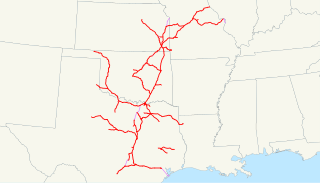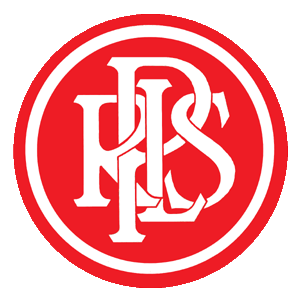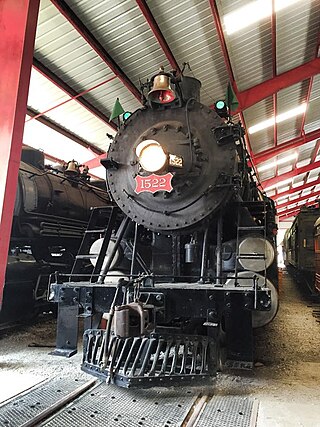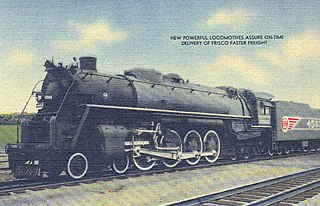
The Missouri–Kansas–Texas Railroad was a Class I railroad company in the United States, with its last headquarters in Dallas, Texas. Established in 1865 under the name Union Pacific Railroad (UP), Southern Branch, it came to serve an extensive rail network in Texas, Oklahoma, Kansas, and Missouri. In 1988, it merged with the Missouri Pacific Railroad; today, it is part of UP.

The Atchison, Topeka and Santa Fe Railway, often referred to as the Santa Fe or AT&SF, was one of the largest Class 1 railroads in the United States.

The EMD E8 is a 2,250-horsepower (1,678 kW), A1A-A1A passenger-train locomotive built by General Motors' Electro-Motive Division (EMD) of La Grange, Illinois. A total of 450 cab versions, or E8As, were built from August 1949 to January 1954, 447 for the U.S. and 3 for Canada. 46 E8Bs were built from December 1949 to January 1954, all for the U.S. The 2,250 hp came from two 12 cylinder model 567B engines, each driving a generator to power the two traction motors on one truck. The E8 was the ninth model in the line of passenger diesels of similar design known as EMD E-units. Starting in September 1953, a total of 21 E8As were built which used either the 567BC or 567C engines.

The Pennsylvania-Reading Seashore Lines was a railroad that operated in South Jersey in the 20th century. It was created in 1933 as a joint consolidation venture between two competing railroads in the region: the Pennsylvania Railroad and the Reading Company.

The St. Louis–San Francisco Railway, commonly known as the "Frisco", was a railroad that operated in the Midwest and South Central United States from 1876 to November 21, 1980. At the end of 1970, it operated 4,547 miles (7,318 km) of road on 6,574 miles (10,580 km) of track, not including subsidiaries Quanah, Acme and Pacific Railway and the Alabama, Tennessee and Northern Railroad; that year, it reported 12,795 million ton-miles of revenue freight and no passengers. It was purchased and absorbed into the Burlington Northern Railroad in 1980. Despite its name, it never came close to San Francisco.
The Valley Flyer was a short-lived named passenger train of the Atchison, Topeka and Santa Fe Railway. The all-heavyweight, "semi-streamlined" train ran between Bakersfield and Oakland, California during the 1939–1940 Golden Gate International Exposition on Treasure Island in San Francisco Bay. Motive power was two Baldwin-built 1300 class 4-6-2 "Pacific" locomotives refurbished and decorated for the train. It was the Santa Fe's first attempt at streamlining older steam power.

Oklahoma City Union Depot is a building in Oklahoma City, Oklahoma that served as a "union station" from 1931 until 1967. It was listed on the National Register of Historic Places in 1979. It now houses the offices of the Scissortail Park Foundation.
The Sand Springs Railway is a class III railroad operating in Oklahoma. It was originally formed in 1911 by industrialist Charles Page to connect his newly formed city of Sand Springs to Tulsa, operating both as a passenger carrying interurban and a freight carrier. At Sand Springs, the company also served his children's home, and Page directed all railroad profits to support the home's operations.

The Museum of the American Railroad, formerly known as the Age of Steam Railroad Museum, is a railroad museum in Frisco, Texas. The museum has more than 70 pieces of steam, diesel, passenger, and freight railroad equipment sitting on 15 acres making it one of the largest historic rail collections in the US. Guests may walk through some of the equipment on guided tours.

The Texas Special was a named passenger train operated jointly by the Missouri–Kansas–Texas Railroad and the St. Louis–San Francisco Railway. It was the flagship of both these lines, operating between St. Louis, Missouri, and San Antonio, Texas, from 1915 until 1959, after which time the Katy changed the northern destination from St Louis to Kansas City after the Frisco discontinued service from St. Louis.

St. Louis–San Francisco Railway 1522 is a two-cylinder, simple class T-54 4-8-2 "Mountain" type steam locomotive built in 1926 by the Baldwin Locomotive Works for the St. Louis–San Francisco Railway (SLSF), also known as the "Frisco". It was retired by the Frisco in 1951 and in May 1959 donated to the National Museum of Transportation in St. Louis, Missouri, where it is currently on display. It was restored to operating condition in the spring of 1988 and operated in excursion service until the fall of 2002 when it was placed back into retirement at the museum.
The Belton, Grandview and Kansas City Railroad (SHRX) is short line passenger railroad and museum located in Belton, Missouri. It operates as a heritage railroad, on what was once the St. Louis and San Francisco Railway (Frisco), on the Kansas City to Springfield branch. With the merger of the Frisco with the Burlington Northern, the line was partially sold to the Kansas City Southern Railway north of 155th Street. The north of the line is used once a year when tree trimming/weed spraying takes place, and the tracks are bad though can still can be used. The bridge is still there past Markey Road but with missing ties, while the southernmost portion from Peculiar, MO. to Clinton, MO. has been scrapped and abandoned. This left the remaining trackage of a few miles connecting Grandview and Belton, Missouri. The railroad currently operates a 1952 GM GP 9 locomotive, which is used to pull an excursion train. Also included in the railroad's collection are various locomotives, cars and equipment.
The Pennsylvania Railroad's class L2s was a class of USRA Light Mikados originally purchased (1919) for the subsidiary Grand Rapids and Indiana Railroad. Similar in size to the home-designed and built L1s, the L2s was easily distinguishable by their radial-stay fireboxes and Hodges fabricated trailing trucks. They were built by ALCO. All were retired in 1948.

The Firefly was a streamlined passenger train operated by the St. Louis – San Francisco Railway. At various times, it served St Louis, Missouri, Tulsa and Oklahoma City, Oklahoma, Kansas City, Missouri, and Fort Scott, Kansas. It made its maiden run on March 29, 1940, and ended May 22, 1960. It was Frisco’s first streamliner, and the first streamliner to be built in the southwest.

The Russian locomotive class Ye, and subclasses Yea, Yek, Yel, Yef, Yem, Yemv and Yes were a series of 2-10-0 locomotives built by American builders for the Russian railways in World War I and again in World War II. They were lightweight engines with relatively low axle loadings.
St. Louis–San Francisco 1352 is an Alco built 2-8-2 Steam locomotive. Built in 1912 as a 2-8-0 Consolidation-type by the American Locomotive Company of Schenectady, New York, for the St. Louis–San Francisco Railway, the engine was later rebuilt into a 2-8-2 Mikado-type to keep up with the traffic demands from World War II. After being retired from the Frisco, the locomotive was moved to many locations under several owners, until it ended up in a small engine house in Rural, Illinois. The locomotive was disassembled by a group with the intent to restore it to operation. Later, the American Steam Railroad ("ASR") was founded, and they purchased the No. 1352 locomotive in 2008 with the hopes of restoring it to operating condition. However, it was left partially disassembled in Taylorville, Illinois, due to the ASR being busy working on restoring another steam locomotive Reading 2100. In November 2023, the No. 1352 locomotive was purchased by the Valley Railroad located in Essex, Connecticut.
The St. Louis, San Francisco and Texas Railway was a subsidiary railway to the St. Louis-San Francisco Railway (Frisco) operating 159 miles of railway line in Texas. The Frisco, including the subsidiary, formed a large X-shaped system across the states of Kansas, Missouri, Oklahoma, Texas, Arkansas, Mississippi and Alabama. It merged into SLSF at the beginning of 1964; SLSF merged into the Burlington Northern Railroad in 1980.

St. Louis–San Francisco Railway locomotive 4500 is a 4-8-4 Northern type steam engine.

The St. Louis–San Francisco class 4500 was a class of 25 4-8-4 "Northern" type steam locomotives built by the Baldwin Locomotive Works between 1942-1943 and operated by the St. Louis–San Francisco Railway.
The Route 66 Historical Village at 3770 Southwest Boulevard in Tulsa, Oklahoma, is an open-air museum along historic U.S. Route 66. The village includes a 194-foot-tall (59 m) oil derrick at the historic site of the first oil strike in Tulsa on June 25, 1901, which helped make Tulsa the "Oil Capital of the World". In a nod to Route 66, it has the Route 66 Village Station, a tourism information center modeled after a 1920s-1930s gas station, which includes a giant Route 66 map for travelers.















